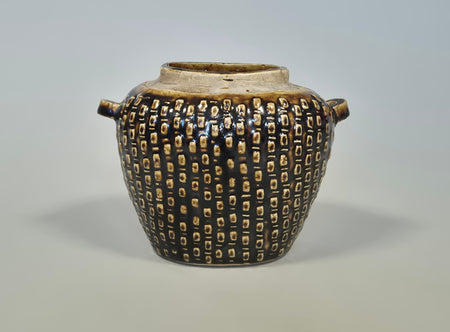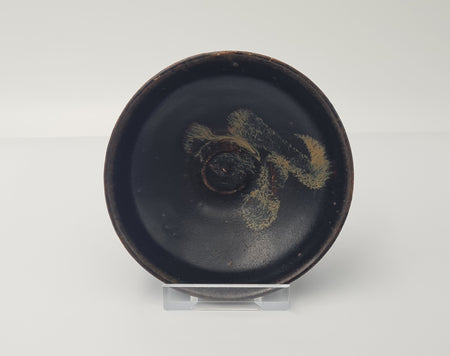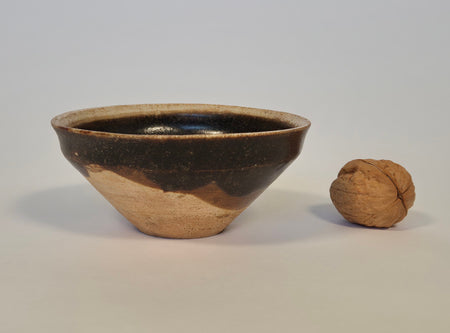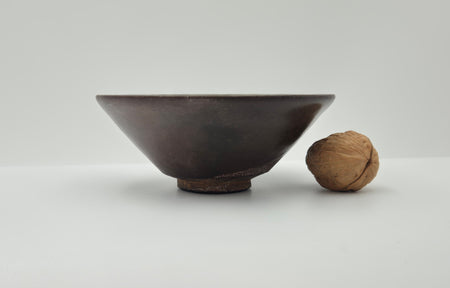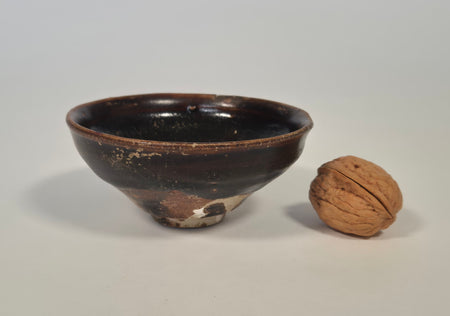Brown and Black wares

Black-glazed wares were relatively uncommon in early Chinese stoneware production. Most ancient Chinese stoneware glazes were typically different shades of green with iron oxide content ranging between 2% and 3%. These iron levels are characteristic of glazes made from wood ash or a combination of wood ash and stoneware clays, both of which are naturally low in iron. To achieve true black or brown glaze effects, a higher concentration of iron oxide, between 5% and 10%, would have been required. This could be accomplished by using unusually iron-rich clays, rocks, or ashes, or by deliberately adding a concentrated iron oxide source to the traditional greenware glazes.
Given the conservative nature of the Chinese greenware tradition, it's not surprising that blackware glazes were rare in early archaeological finds, even though there are examples from late Shang and onwards. Greenwares remained the dominant high-fired glaze in China until the early 4th century AD, when small quantities of black-glazed stoneware began to be produced in Zhejiang province at kiln sites in Deqing and Yuhang. Even then, these darker wares were not particularly popular, and it wasn’t until the Tang dynasty that black-glazed stonewares became more prominent. During this time, some of the finest Tang blackwares were produced in kilns located in the Yellow River region of northern China.
Northern Blackwares
By the Tang dynasty, most dark-glazed ceramics were produced in northern China, particularly in the provinces of Henan, Hebei, and Shaanxi. The glazes of this period became more stable, resulting in a smoother and more consistent finish. These rich, lustrous glazes were often compared to the finest brown and black lacquerware of the time. The shapes were sometimes elegant, drawing inspiration from the popular silverware of the era. The glazes used in Tang ceramics were typically darker than the early Zhejiang examples, often appearing black when applied thickly. They also displayed a wider range of hues, from chocolate brown to russet tones.
Most Tang dark-glazed ceramics were undecorated, relying on the refined form and the beauty of the glaze for visual appeal. However, a few pieces incorporated moulded designs. Vessels typically had solid bases rather than distinct footrings, with the glaze stopping above the foot, leaving the lower portion of the clay body exposed. The Yaozhou potters at Huangbao primarily produced dark-glazed ceramics during the Tang dynasty. The kiln was famous for creating tea-dust glazes alongside its brown and black wares, and the potters also painted or trailed the glazes leaving areas of the body unglazed. Kilns in Lushan and Huangdao, Henan are famous for their high-quality black wares decorated with sky blue/white splashes produced in the Tang dynasty, but similar wares were also produced at the Yaozhou kilns at the time.
In the Song, Jin and Yuan periods, more sophisticated styles of glazes were produced. There was a general increase in firing temperature and clays became more refined. Decoration often consisted of iron brown splashes or paintings. The non-vitrifying clays in northern China allowed thinner potting and more possibilities when it comes to shapes, than was possible in southern China. The most desirable vessels were produced by the Ding kilns in Hebei and Yaozhou kilns in Shaanxi in Song and Jin periods. Northern blackwares were produced in a large variety of shapes, unlike those produced in south China which were more limited in form.
Southern Blackwares
A large part of the blackware production in southern China was represented by tea bowls in various shapes. Blackwares were produced all over southern China, but the most famous production centers were situated in northern Fujian (Jian kilns) and in central Jiangxi (Jizhou kilns).
Jian
Situated in Shuiji, near Jianyang, in northern Fujian, the Jian kilns were active from Tang to Yuan dynasty. From the 11th century to the late 14th century, they almost exclusively produced to dark glazed tea bowls. These bowls were produced in seven distinct shapes, all with a thick dark brown glaze with various decorative patterns, usually with the lower portion of the body unglazed. Among the most famous decorative effects of the glaze are the “hare’s fur” and the “oil-spot” effect. They were fired in single saggers in large Dragon kilns, with a firing temperature between 1300 and 1330°C.
Initially produced as common ware, the tea bowls became popular nation-wide and as early as the 12th century, Japanese Monks started to carry bowls back to Japan. Later, in the 13th century, Japan was importing such bowls in large quantities. Jian kilns also supplied tribute ware to the court and some examples have characters stamped to the base reading “imperial tribute”.
Jizhou
Jizhou kilns were located in Yonghe Town, Ji'an, in Jiangxi province. This region, situated near the Gan River, provided the essential natural resources, including local clay and wood for firing, that facilitated the production of Jizhou ware. The kilns were possibly established in Tang and active through Yuan and likely into the Ming. The best wares were produced during southern Song.
The kilns became known for its artistic creativity and technical innovation. The products were primarily used for daily life and tea ceremonies, yet they are highly valued today for their distinctive decorative techniques and unique glazes.
Jizhou ware is characterized by its dark brown to black glazes, often applied over a coarse stoneware body, which compared to Jian ware, is rather dull. They were typically fired in temperatures between 1220 and 1290°C. What sets it apart is the wide range of decorative methods employed by the potters. One popular technique was resist decoration, where organic materials like plant leaves or paper cutouts were applied to the surface before glazing, leaving intricate natural patterns once the glaze was fired. Another iconic style was the "tortoiseshell" effect, achieved by dripping lighter glazes onto the dark background to create a mottled appearance.
In addition to these techniques, Jizhou potters also experimented with "tea-dust" glazes, which featured a speckled surface caused by crystallization during firing. The ability of the Jizhou potters to vary glaze colors and textures, using simple yet effective methods, made these wares particularly appreciated during the Song dynasty.
